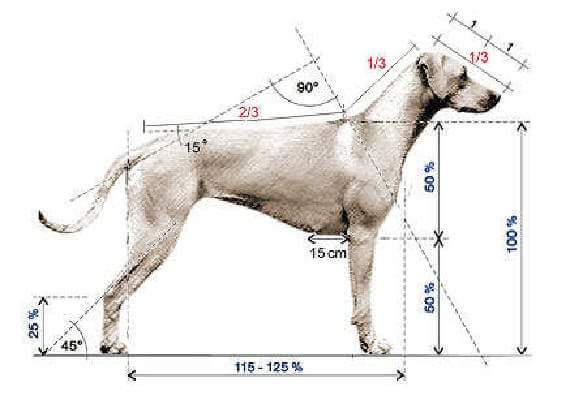
Each purebred dog breed recognized by the AKC has a written Standard detailing the characteristics defining that breed.
The official standard originates with an AKC parent club, the national organization devoted to that particular breed. Parent-club members vote on the standard, which may be revised from time-to-time, then the club submits it to the AKC. This standard then is used by dog-show judges to evaluate the quality of an animal. It’s not how cute my Rover is compared to your Rover, but rather how closely my Rover compares to the “word picture” as determined by a judge that matters. The Rhodesian Ridgeback Club of the United States, RRCUS, is the official club for the US that standard for this breed.
Here is Official Rhodesian Ridgeback Breed Standard as listed by RRCUS.
General Appearance
The Ridgeback represents a strong, muscular and active hound, symmetrical and balanced in outline. A mature Ridgeback is a handsome, upstanding and athletic dog, capable of great endurance with a fair (good) amount of speed. Of even, dignified temperament, the Ridgeback is devoted and affectionate to his master,reserved with strangers. The peculiarity of this breed is the ridge on the back. The ridge must be regarded as
the characteristic feature of the breed.
Size, Proportion, Substance
A mature Ridgeback should be symmetrical in outline, slightly longer than tall but well balanced. Dogs: 25 to 27 inches in height; Bitches: 24 to 26 inches in height.
Desirable weight:Dogs: 85 pounds; Bitches:70 pounds.
Head
Should be of fair length, the skull flat and rather broad between the ears and should be free from wrinkles when in repose. The stop should be reasonably well defined.
Eyes–should be moderately well apart and should be round, bright and sparkling with intelligent expression,their color harmonizing with the color of the dog.
Ears–should be set rather high, of medium size, rather wide at the base and tapering to a rounded point. They should be carried close to the head.
Muzzle–should be long, deep and powerful. The lips clean, closely fitting the jaws. Clear faced or masked dogs are equally correct and neither is preferred. A clear face with black or brown/liver pigmentation only on nose, lips, and around the eyes, or a masked face with black or brown/liver pigmentation is correct as long as the color is not continuing with a solid mask over the eyes. A darker ear often accompanies the darker masked dog.
Nose–should be black, brown or liver, in keeping with the color of the dog. No other colored nose is permissible. A black nose should be accompanied by dark eyes, a brown or liver nose with amber eyes.
Bite–jaws level and strong with well-developed teeth, especially the canines or holders. Scissors bite preferred.
Neck, Topline, Body
The neck should be fairly long. It should be strong, free from throatiness and in balance with the dog. The chest should not be too wide, but very deep and capacious, ribs moderately well sprung, never rounded like barrel hoops (which would indicate want of speed). The back is powerful and firm with strong loins which are muscular and slightly arched. The tail should be strong at the insertion and generally tapering towards the end, free from coarseness. It should not be inserted too high or too low and should be carried with a slight curve upwards, never curled or gay.
Forequarters
The shoulders should be sloping, clean and muscular, denoting speed. Elbows close to the body. The forelegs should be perfectly straight, strong and heavy in bone. The feet should be compact with well-arched toes, round, tough, elastic pads, protected by hair between the toes and pads. Dewclaws may be removed.
Hindquarters
In the hind legs the muscles should be clean, well defined and hocks well down. Feet as in front.
Coat
Should be short and dense, sleek and glossy in appearance but neither woolly nor silky.
Color
Light wheaten to red wheaten. A little white on the chest and toes permissible but excessive white there, on the belly or above the toes is undesirable. (see muzzle)
Ridge
The hallmark of this breed is the ridge on the back which is formed by the hair growing in the opposite direction to the rest of the coat. The ridge must be regarded as the characteristic feature of the breed. The ridge should be clearly defined, tapering and symmetrical. It should start immediately behind the shoulders and continue to a point between the prominence of the hips and should contain two identical crowns
(whorls) directly opposite each other. The lower edge of the crowns (whorls) should not extend further down the ridge than one third of the ridge.
Disqualification: Ridgelessness. Serious Fault: One crown (whorl) or more than two crowns (whorls).
Gait
At the trot, the back is held level and the stride is efficient, long, free and unrestricted. Reach and drive expressing a perfect balance between power and elegance. At the chase, the Ridgeback demonstrates great coursing ability and endurance.
Temperament
Dignified and even tempered. Reserved with strangers.
Scale of Points
General appearance, size, symmetry and balance 15
Ridge 20
Head 15
Legs and feet 15
Neck and shoulders 10
Body, back, chest and loin 10
Gait 10
Coat and color 3
Tail 2
Total 100
Disqualification
Ridgelessness
Approved August 11, 1992
Effective September 30, 1992
Effective March 31, 2010
